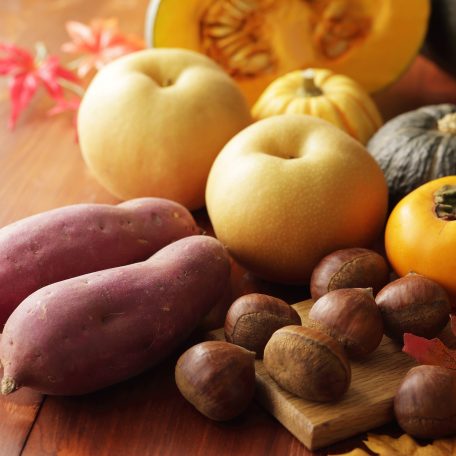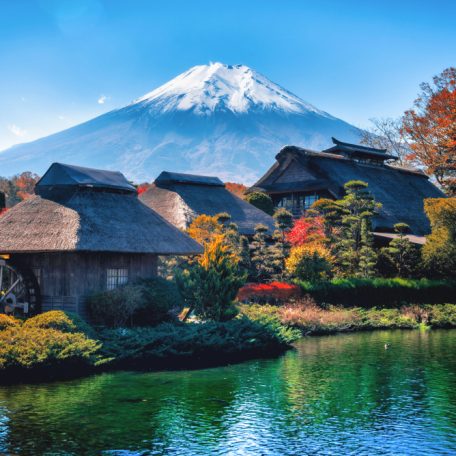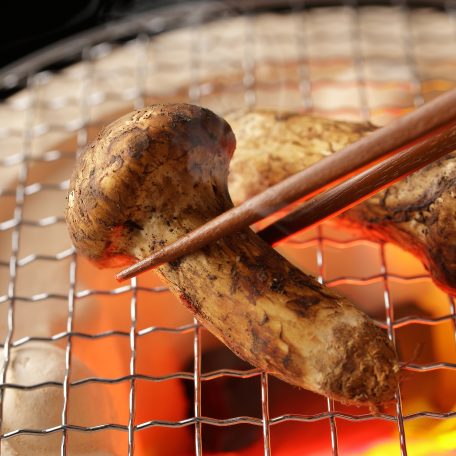Japanese Sweet Potato – A Delightful Staple to Enjoy During Autumn in Japan!
Oct 14, 2023
BY Shalini Sookoo

As summer ends and fall begins to settle in, a delicious aroma can be found drifting in the air. Sweet with a chestnut-like flavour, Japanese sweet potatoes (satsuma-imo) are harvested at this time of the year. As a staple of autumn, it is not only a reminder of the changing seasons, but can also bring about a sense of nostalgia for many people.
So what makes Japanese sweet potatoes standout from sweet potatoes found in other countries? Well, satsuma-imo (or kara-imo as it is called in Kyushu) is much starchier, drier and firmer in texture. The interior of an uncooked satsuma-imo can be yellow, white or purple depending on the variety of satsuma-imo, whilst the skin is usually red or purple with tapered ends.
Sweet potatoes were brought to Okinawa from China approximately 1600 years ago. In 1705, a sailor from Kagoshima brought back sweet potatoes from Okinawa to Kagoshima. Due to the rich volcanic soil and ideal climate, sweet potatoes quickly spread throughout Japan. Currently, Kagoshima holds its stance as the largest producer of sweet potatoes in Japan and is renowned as ‘The Land of Sweet Potatoes’.
Types of Sweet Potatoes
Japan has many varieties of sweet potatoes! Developments in breeding techniques have not only improved crop yields, but have also increased the number of varieties available. Let’s list a few popular varieties:
Murasaki-imo
The vibrant purple interior of the murasaki-imo is due to a naturally occurring chemical compound called anthocyanin. Since murasaki-imo is not very sweet, it’s usually used in manufactured and packaged products. In 2002, a variation of murasaki-imo called the ‘Purple Sweet Road’ was nationally registered. This variation is more suitable for cooking and was created by crossbreeding a purple sweet potato from Kyushu with several other sweet potato varieties including kintoki.
Naruto Kintoki-imo
Naruto kintoki-imo is produced in the Tokushima Prefecture, specifically Naruto City. With its mild climate, little rainfall, and sandy soil rich in ocean minerals, this region is ideal for sweet potato cultivation. Naruto kintoki-imo has a high sugar concentration and a golden interior which becomes soft and fluffy when cooked.
Anno-imo
Anno-imo is cultivated in Tanegashima, an island in Kagoshima Prefecture. It is sweet in flavour due to its high sugar content. When cooked, the pale orange interior turns bright yellow.
Foods and Snacks
There are many ways to prepare and enjoy sweet potatoes. First and foremost, the sweet potatoes must be soaked in water to remove the starch. After soaking, they can be roasted, baked, simmered, boiled or deep fried. Sweet potatoes are a versatile food that can be used in both sweet or savoury dishes. Now let’s dive in and have a look at a few popular sweet potato dishes!
Yakiimo (Roasted Sweet Potato)
You can often find food trucks throughout Japan selling this popular, mouth-watering snack. Yakiimo is prepared by first washing the sweet potatoes to remove the dirt, then roasting them in the stone oven at the back of the truck. This delicious treat is sweet and creamy and does not need any added salt, seasonings or butter (I mean it!).

Photo credit: @italiansinjapan on Instagram
The texture is velvety, which compliments the strong flavour. This snack is a favourite during the colder months and can be eaten with the skin. If you’re in Tokyo, you might want to check out the Shinagawa Yakiimo Terrace held every year from the end of January to the beginning of February. This sweet potato festival allows businesses to exhibit new snacks for the upcoming autumn and winter seasons.
Double Baked Sweet Potato
Compared to the savoury yakiimo, this baked sweet potato is a delicious dessert! The satsuma-imo is first washed and then baked in the oven to soften the interior. The flesh is then removed and pureed, then combined with eggs, sugar, butter, heavy cream or milk and a splash of vanilla essence for added flavour. The mixture is then refilled into the sweet potato skin. Then, it is ready to be baked once more!

Photo Credit: Namiko Chen from Justonecookbook
Daigaku-imo (Candied Sweet Potatoes)
In the 1900’s, this was a popular snack among university students in Tokyo and can still be found at many stalls and school festivals today! The sweet potatoes are washed and cut into bite-sized pieces before being deep fried. A candy syrup, made of rice vinegar, soy sauce, sugar and water, is used to thoroughly coat the sweet potatoes. Then, they are garnished with black sesame seeds. This sweet dish has a delightful crunch from the sweet potato skin, as well as a smooth, buttery texture from the sweet potato flesh.

Photo Credit: Shihoko from Chopstick Chronicles.
Kuri Kinton
This dish is a popular osechi-ryori (Japanese New Year’s meal), and is a symbol of prosperity and good luck for the upcoming year. Simmered with gardenia pods for a vibrant yellow color, the sweet potatoes are then mashed or pureed, before being combined with sugar, salt, mirin and candied chestnut syrup. Finally, candied chestnuts are added as a garnish. Although this dish is known to be savoury, it is actually sweet!

Photo Credit: Shihoko from Chopstick Chronicles
Sweet potatoes can be added in a variety of dishes and snacks, from traditional Japanese confectionery to miso soups, cakes and parfaits. The possibilities are endless, as are the places where you can get these tasty treats! Convenience stores, cafes, restaurants and food trucks are just a few of the places where you can try this seasonal food. If you want to enjoy delicious sweet potatoes in a variety of different ways, Japan is guaranteed to be the best place to visit!

Photo credit: @italiansinjapan on Instagram
There are more yummy fall flavors to explore on this blog post about Japanese Autumn tasty foods.
Join a tour in Tokyo and enjoy delicious dishes to make the Tastiest memories!
Featuring photo credit:@italiansinjapan on Instagram
PIN THIS FOR LATER
Book your pocket wifi now to stay connected through your entire Japan Journey!

Be sure to get the JR Pass to make navigating Japan during your trip that much easier!

YOU MIGHT ALSO LIKE





